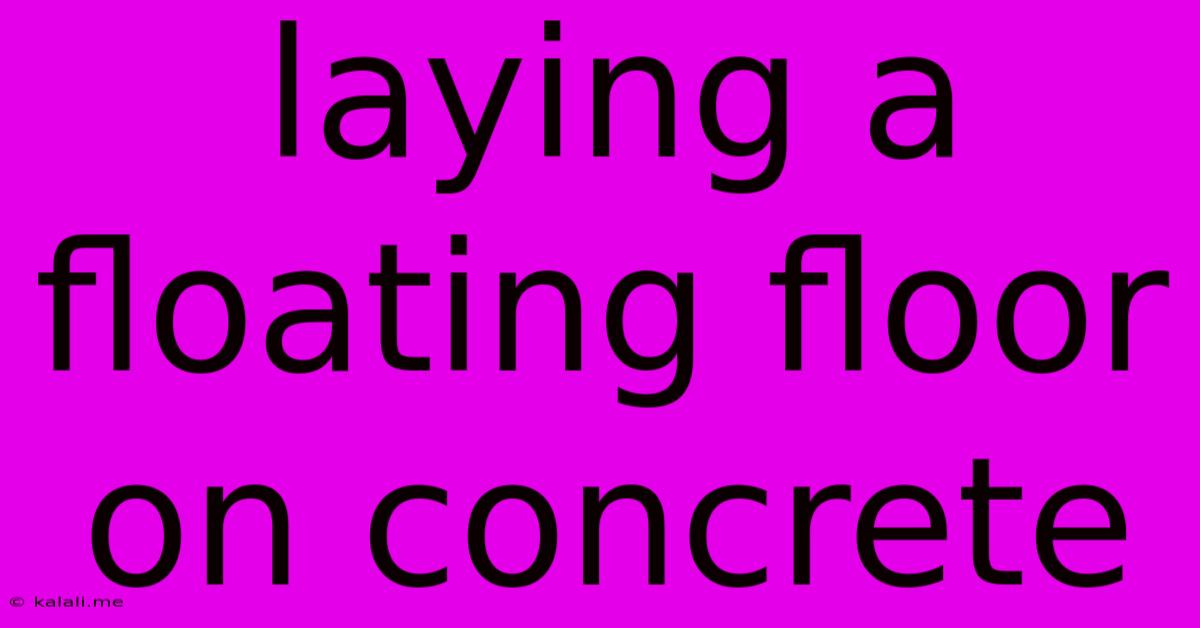Laying A Floating Floor On Concrete
Kalali
May 21, 2025 · 4 min read

Table of Contents
Laying a Floating Floor on Concrete: A Comprehensive Guide
Meta Description: Learn how to successfully install a floating floor on a concrete subfloor. This comprehensive guide covers preparation, installation, and troubleshooting, ensuring a beautiful and long-lasting floor.
Installing a floating floor on a concrete subfloor is a popular DIY project, offering a cost-effective way to upgrade your home's aesthetic and comfort. This guide provides a step-by-step walkthrough, addressing common challenges and ensuring a professional finish. Whether you're using laminate, engineered wood, or vinyl, the core principles remain the same. Let's get started!
1. Preparing Your Concrete Subfloor: The Foundation for Success
A perfectly prepared subfloor is crucial for a successful floating floor installation. Neglecting this step can lead to unevenness, squeaking, and premature wear. Here's what you need to do:
- Cleanliness is Key: Thoroughly clean the concrete surface. Remove any debris, dust, dirt, and old adhesive residue using a broom, vacuum cleaner, and potentially a damp mop. A clean surface ensures optimal adhesion of the underlayment.
- Moisture Measurement: Concrete moisture is a major concern. High moisture levels can lead to mold growth and damage your flooring. Use a moisture meter to check the moisture content. Most floating floor manufacturers specify maximum moisture levels; ensure your concrete falls within those limits. Consider using a moisture barrier if necessary.
- Leveling the Floor: Uneven concrete is a recipe for disaster. Assess the levelness of your concrete using a long, straight edge and a level. Small imperfections can be addressed with a self-leveling compound. For larger imperfections, consider grinding the concrete to create a more even surface.
- Cracks and Gaps: Repair any significant cracks or gaps in the concrete using a suitable patching compound. This ensures a stable and even base for your floating floor.
2. Choosing the Right Underlayment: More Than Just a Cushion
Underlayment acts as a buffer between your concrete subfloor and your floating floor. It provides several crucial benefits:
- Sound Insulation: Reduces sound transmission, creating a quieter living environment.
- Moisture Barrier: Provides an additional layer of protection against moisture from the concrete.
- Impact Absorption: Adds cushioning and comfort underfoot.
- Leveling: Helps to minimize minor imperfections in the subfloor.
Select an underlayment appropriate for your chosen flooring type and the specific conditions in your room. Always check the manufacturer's recommendations.
3. Installing Your Floating Floor: A Step-by-Step Guide
Now comes the exciting part – installing your floating floor! Remember, patience and precision are key.
- Acclimation: Allow your flooring to acclimate to the room's temperature and humidity for at least 48 hours before installation. This prevents expansion and contraction issues later.
- Starting the Installation: Begin laying your flooring in a straight line, ensuring a tight fit between boards. Use spacers to maintain a consistent expansion gap around the perimeter of the room.
- Click or Glue: Follow the manufacturer's instructions for your specific flooring type. Most floating floors use a click-lock system, but some may require adhesive.
- Cutting and Fitting: You'll likely need to cut boards to fit around obstacles like pipes and doorways. Use a sharp utility knife or circular saw with a fine-tooth blade.
- Expansion Gaps: Maintain consistent expansion gaps (typically 1/4 inch) around the perimeter of the room and between walls and the flooring. This allows for natural expansion and contraction due to changes in temperature and humidity.
4. Finishing Touches and Troubleshooting
Once the installation is complete, it's time to add the finishing touches and address any potential issues:
- Baseboards: Install baseboards to conceal the expansion gap and enhance the overall aesthetic.
- Transition Strips: Use transition strips where the floating floor meets other flooring types.
- Squeaking: If you experience squeaking, it's often due to insufficient underlayment or uneven subfloor. Addressing these issues before installation is crucial.
- Unevenness: If sections of the floor feel uneven, it indicates issues with the subfloor preparation.
5. Choosing the Right Flooring for Your Needs
Different floating floors suit different needs and lifestyles:
- Laminate: A budget-friendly option, offering a wide range of styles and finishes.
- Engineered Wood: More durable and water-resistant than solid hardwood, suitable for high-traffic areas.
- Luxury Vinyl Plank (LVP): Highly durable, waterproof, and easy to maintain. A popular choice for kitchens and bathrooms.
By following these steps, you can successfully install a beautiful and durable floating floor on your concrete subfloor, adding value and style to your home. Remember to always consult the manufacturer's instructions for your specific flooring type. Happy flooring!
Latest Posts
Latest Posts
-
What Do You Say To Someone Going On Maternity Leave
May 22, 2025
-
Red Cross With Blue Background Road Sign
May 22, 2025
-
Why Does Sodium Chloride Not Conduct Electricity
May 22, 2025
-
Pit Bull And Bull Terrier Mix
May 22, 2025
-
Can You Put Aerosols In Hold Luggage
May 22, 2025
Related Post
Thank you for visiting our website which covers about Laying A Floating Floor On Concrete . We hope the information provided has been useful to you. Feel free to contact us if you have any questions or need further assistance. See you next time and don't miss to bookmark.